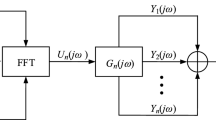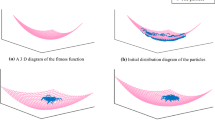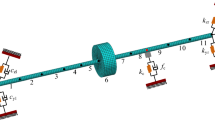Abstract
Large-sized rotating machines usually contain weak feature information of rub-impact fault, which is hard to extract. General scale transformation stochastic resonance (GSTSR) can match input signals with different frequencies by using the optimal barrier height and boost the weak fault feature in signals. The performance of GSTSR is determined by systemic parameters. When a rub-impact fault occurs between rotor and stator, vibration signals are often accompanied by an impact. Therefore, the paper takes advantage of sensibility of waveform factor to rub-impact fault information and margin factor to impact properties of signal and reconstructs a new signal evaluation index based on waveform and margin factors. The signal evaluation index is treated as the fitness function of grey wolf optimization (GWO) algorithm and combined with GSTSR to perform a comprehensive evaluation to rub-impact fault feature information. The result of comparison with conventional method (with signal to noise ratio (SNR) as fitness function) indicates that in case of extracting rub-impact fault features, the proposed method identifies a rotor-stator rub-impact fault more precisely than the classical method.







Similar content being viewed by others
References
P.C. Yu, Y.H. Ma, J. Hong, G. Chen, Application of complex nonlinear modes to determine dry whip motion in a rubbing rotor system. Chin. J. Aeronaut. 34(01), 209–225 (2021). https://doi.org/10.1016/j.cja.2020.09.049
Z. Meng, M. Lv, Z.H. Liu, F.J. Fan, General synchroextracting chirplet transform: Application to the rotor rub-impact fault diagnosis. Measurement. 169, 108523 (2021). https://doi.org/10.1016/j.measurement.2020.108523
M.Y. Yu, A novel intrinsic time-scale decomposition-graph signal processing-based characteristic extraction method for rotor-stator rubbing of aeroengine. J. VIB CONTROL. 28, 902–914 (2022). https://doi.org/10.1177/1077546320985968
Y. Zhang, B.W. Li, Noise reduction method for nonlinear signal based on maximum variance unfolding and its application to fault diagnosis. Sci. China Technol. Sci. 53(08), 2122–2128 (2010). https://doi.org/10.1007/s11431-009-3172-8
F. Miao, R.Z. Zhao, A new method of vibration signal denoising based on improved wavelet. J. LOW FREQ NOISE V A. 41(02), 637–645 (2022). https://doi.org/10.1177/14613484211051857
N.Q. Hu, M. Chen, X.S. Wen, The application of stochastic resonance theory for early detecting rub-impact fault or rotor system. Mech. Syst. Signal Process. 17(04), 883–895 (2003). https://doi.org/10.1006/mssp.2002.1470
X.J. Gu, C.Z. Chen, Adaptive parameter-matching method of SR algorithm for fault diagnosis of wind turbine bearing. J. Mech. Sci. Technol. 33, 1007–1018 (2019). https://doi.org/10.1007/s12206-019-0202-8
B.M. Xu, J.C. Shi, M. Zhong, J. Zhang, Incipient fault diagnosis of planetary gearboxes based on an adaptive parameter-induced stochastic resonance method. Appl. Acoust. (2022). https://doi.org/10.1016/j.apacoust.2021.108587
T.Y. Wang, Y.G. Leng, Numerical research of twice sampling stochastic resonance for the detection of a weak signal submerged in a heavy Noise. Acta Phys. Sin. 10, 2432–2437 (2003)
Z.H. Jiang, F. Xie, H.N. Wang, Condition monitoring of tools with normalized variable-scale stochastic resonance. Mech. Sci. Technol Aerosp Eng. 39, 1520–1525 (2020). https://doi.org/10.13433/j.cnki.1003-8728.20190266
Yang, J.H. Zhou, D.J. (Re-scaled Resonance Theory and Application in Fault Diagnosis), Science Press, Beijing 2020, p. 10
D.W. Huang, J.H. Yang, D.J. Zhou, G. Litak, Novel adaptive search method for bearing fault frequency using stochastic resonance quantified by amplitude-domain index. IEEE Trans. Instrum. Meas. 69(01), 109–121 (2020). https://doi.org/10.1109/TIM.2019.2890933
H.N. Cong, M.Y. Yu, Y.H. Gao, M.H. Fang, A new method for rubbing fault identification based on the combination of improved particle swarm optimization with self-adaptive stochastic resonance. J. Fail. Anal. Prev. 22, 690–703 (2022). https://doi.org/10.1007/s11668-022-01365-1
P. Zhou, S.L. Lu, F. Liu, Y.B. Liu, G.H. Li, J. Zhao, Novel synthetic index-based adaptive stochastic resonance method and its application in bearing fault diagnosis. J. Sound Vib. 391, 194–210 (2017). https://doi.org/10.1016/j.jsv.2016.12.017
Z.H. Lai, S.B. Wang, G.Q. Zhang, C.L. Zhang, J.W. Zhang, Rolling bearing fault diagnosis based on adaptive multiparameter-adjusting bistable stochastic resonance. Shock Vib. (2020). https://doi.org/10.1155/2020/6096024
B. He, Y. Huang, D.Y. Wang, B. Yan, D.W. Dong, A parameter-adaptive stochastic resonance based on whale optimization algorithm for weak signal detection for rotating machinery. Measurement. 136, 658–667 (2019). https://doi.org/10.1016/j.measurement.2019.01.017
B.C. Li, R. Tong, J.S. Kang, K. Chi, Bearing fault diagnosis using synthetic quantitative index-based adaptive underdamped stochastic resonance. Math. Probl. Eng. (2021). https://doi.org/10.1155/2021/8888079
X.D. Sun, Y. Zhang, X. Tian, J.H. Cao, J.G. Zhu, Speed sensorless control for IPMSMs using a modified MRAS with gray wolf optimization algorithm. IEEE Trans. Transp. Electrif. 8, 1326–1337 (2022). https://doi.org/10.1109/TTE.2021.3093580
W.L. Fu, J.W. Tan, X.Y. Zhang, T. Chen, K. Wang, Blind parameter identification of MAR model and mutation hybrid GWO-SCA optimized SVM for fault diagnosis of rotating machinery. Complexity. (2019). https://doi.org/10.1155/2019/3264969
Y.Z. Hou, S.M. Li, S.Q. Gong, J.G. Huang, J.B. Zhang, Hybrid algorithm of filter and improved gray wolf optimization for fault feature selection of rolling bearing. Comp. Integr. Manuf. 29, 1452–1461 (2022). https://doi.org/10.13196/j.cims.2023.05.004
J.T. Lu, T. Yao, S.M. Li, R.Q. Cui, An intelligent fault diagnosis method for rolling bearings based on hybrid characteristics. J. Shock. Vib. 41, 7984176 (2022). https://doi.org/10.13465/j.cnki.jvs.2022.16.011
S.L. Lu, Y.S. Su, J.W. Zhao, Q.B. He, F. Liu, Y.B. Liu, Bearings fault diagnosis based on two-dimensional complementary stochastic resonance. J. Shock. Vib. 37, 71227 (2018). https://doi.org/10.13465/j.cnki.jvs.2018.4.002
Acknowledgments
This work was supported by National Natural Science Foundation of China [grant number: 51605309], Natural Science Foundation of Liaoning Province [grant number: 2022-MS-299], Aeronautical Science Foundation of China [grant number: 201933054002] and Department of Education of Liaoning Province [grant number: LJKMZ20220529].
Author information
Authors and Affiliations
Corresponding author
Ethics declarations
Conflict of interest
The authors declare no conflict of interest in preparing this article.
Additional information
Publisher's Note
Springer Nature remains neutral with regard to jurisdictional claims in published maps and institutional affiliations.
Rights and permissions
Springer Nature or its licensor (e.g. a society or other partner) holds exclusive rights to this article under a publishing agreement with the author(s) or other rightsholder(s); author self-archiving of the accepted manuscript version of this article is solely governed by the terms of such publishing agreement and applicable law.
About this article
Cite this article
Yu, M., Wang, P., Su, J. et al. Self-Adaptive Stochastic Resonance Rub-Impact Fault Identification Grounded on a New Signal Evaluation Index. J Fail. Anal. and Preven. 23, 2118–2130 (2023). https://doi.org/10.1007/s11668-023-01745-1
Received:
Revised:
Accepted:
Published:
Issue Date:
DOI: https://doi.org/10.1007/s11668-023-01745-1




